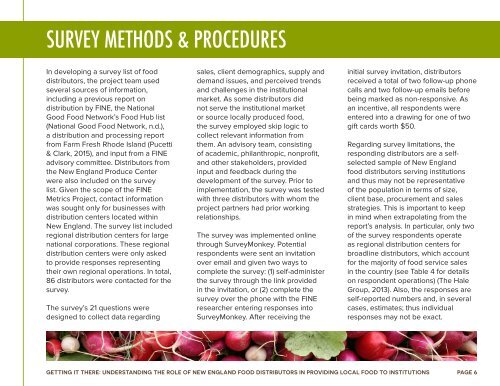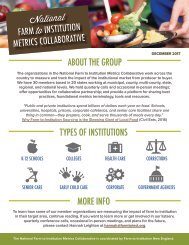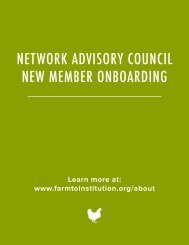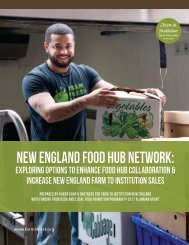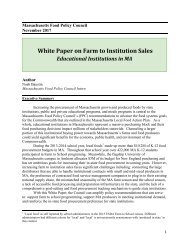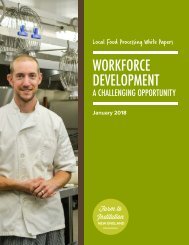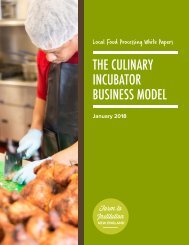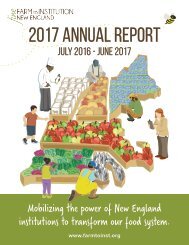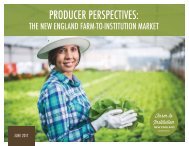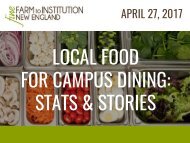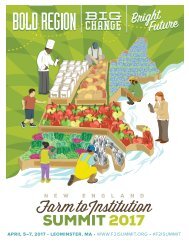FINE Distributor Report
“Getting it There: The Role of New England Food Distributors in Providing Local Food to Institutions” presents in-depth findings and makes specific, data-based recommendations for food distributors (including food hubs) as well as government officials, funders and institutions. The report is based on an original survey answered by over 60 food distributors across New England in the spring of 2015.
“Getting it There: The Role of New England Food Distributors in Providing Local Food to Institutions” presents in-depth findings and makes specific, data-based recommendations for food distributors (including food hubs) as well as government officials, funders and institutions. The report is based on an original survey answered by over 60 food distributors across New England in the spring of 2015.
You also want an ePaper? Increase the reach of your titles
YUMPU automatically turns print PDFs into web optimized ePapers that Google loves.
SURVEY METHODS & PROCEDURES<br />
In developing a survey list of food<br />
distributors, the project team used<br />
several sources of information,<br />
including a previous report on<br />
distribution by <strong>FINE</strong>, the National<br />
Good Food Network’s Food Hub list<br />
(National Good Food Network, n.d.),<br />
a distribution and processing report<br />
from Farm Fresh Rhode Island (Pucetti<br />
& Clark, 2015), and input from a <strong>FINE</strong><br />
advisory committee. <strong>Distributor</strong>s from<br />
the New England Produce Center<br />
were also included on the survey<br />
list. Given the scope of the <strong>FINE</strong><br />
Metrics Project, contact information<br />
was sought only for businesses with<br />
distribution centers located within<br />
New England. The survey list included<br />
regional distribution centers for large<br />
national corporations. These regional<br />
distribution centers were only asked<br />
to provide responses representing<br />
their own regional operations. In total,<br />
86 distributors were contacted for the<br />
survey.<br />
The survey’s 21 questions were<br />
designed to collect data regarding<br />
sales, client demographics, supply and<br />
demand issues, and perceived trends<br />
and challenges in the institutional<br />
market. As some distributors did<br />
not serve the institutional market<br />
or source locally produced food,<br />
the survey employed skip logic to<br />
collect relevant information from<br />
them. An advisory team, consisting<br />
of academic, philanthropic, nonprofit,<br />
and other stakeholders, provided<br />
input and feedback during the<br />
development of the survey. Prior to<br />
implementation, the survey was tested<br />
with three distributors with whom the<br />
project partners had prior working<br />
relationships.<br />
The survey was implemented online<br />
through SurveyMonkey. Potential<br />
respondents were sent an invitation<br />
over email and given two ways to<br />
complete the survey: (1) self-administer<br />
the survey through the link provided<br />
in the invitation, or (2) complete the<br />
survey over the phone with the <strong>FINE</strong><br />
researcher entering responses into<br />
SurveyMonkey. After receiving the<br />
initial survey invitation, distributors<br />
received a total of two follow-up phone<br />
calls and two follow-up emails before<br />
being marked as non-responsive. As<br />
an incentive, all respondents were<br />
entered into a drawing for one of two<br />
gift cards worth $50.<br />
Regarding survey limitations, the<br />
responding distributors are a selfselected<br />
sample of New England<br />
food distributors serving institutions<br />
and thus may not be representative<br />
of the population in terms of size,<br />
client base, procurement and sales<br />
strategies. This is important to keep<br />
in mind when extrapolating from the<br />
report’s analysis. In particular, only two<br />
of the survey respondents operate<br />
as regional distribution centers for<br />
broadline distributors, which account<br />
for the majority of food service sales<br />
in the country (see Table 4 for details<br />
on respondent operations) (The Hale<br />
Group, 2013). Also, the responses are<br />
self-reported numbers and, in several<br />
cases, estimates; thus individual<br />
responses may not be exact.<br />
GETTING IT THERE: UNDERSTANDING THE ROLE OF NEW ENGLAND FOOD DISTRIBUTORS IN PROVIDING LOCAL FOOD TO INSTITUTIONS PAGE 6


